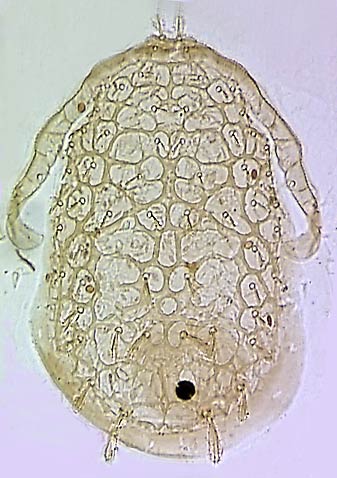
Home | Mesostigmata (Monogynaspida) Home | Glossary
Ameroseiidae soil
Taxonomic Position
Cohort Gamasina
Subcohort Dermanyssiae
Superfamily Ascoidea
Soil/nest/stored product-inhabiting genera:
Ameroseiella Bregetova - 1 sp. (apodius (Karg)); dorsal shield with 29 pairs of mostly densely barbed, foliose setae; corniculi bifurcate distally; leg I without pretarsus, terminating in long setae; pretarsi 2-4 with claws.
Ameroseius Berlese (including Kleemannia Oudemans = Primoseius
Womersley, = Klemannia misspelling) - >30 spp.;
dorsal shield strongly ornamented, often with reticulate ridges, with 29 pairs
of strongly barbed acuminate to foliose setae; sternal shield with 2-3 pairs of
setae; corniculi bifid or toothed distally; genu II with 2 ventral setae;
pretarsi with claws; genu II with one or two (Kleemannia) pl setae;
palp apotele 3-tined or 2-tined (Kleemannia); with anal or ventrianal (Kleemannia)
shield.

Asperolaelaps Womersley - 1 sp. (rotundus Womersley); dorsal shield with 29 pairs of setae: j5, z2, z4, z6, s5, Z2 & S5 thick, pilose and mounted on tubercles; pretarsi with claws. Sometimes placed in Neocypholaelaps.
Brontispalaelaps Womersley - 2 spp.; dorsal shield strongly ornamented, with 27 pairs of mostly long setae; sternal shield with 3 pairs of setae; corniculi bifid distally; genu II without ventral setae; palp apotele 3-tined; pretarsi with claws.
Epicriopsis Berlese - 8 spp.; dorsal shield ornamented with tubercles, with <25 pairs of often elongate, thickened and barbed setae; genu II with 2 ventral setae; palp apotele 3-tined; pretarsi with claws.
Seritympanum Elsen & Whitaker - 3 spp.; dorsal shield strongly sculptured with 28-29 pairs of mostly spatulate to club-shaped setae; setae j1 on bifid, projecting vertex; sternal shield with 2 pairs of setae and three cogwheel-like ornaments; ventrianal shield bearing 2 pairs of ventral setae; corniculi with 3 teeth; palp apotele 2-tined; pretarsi with claws.
Diagnostic characters:
Dorsal shield well sclerotized, often strongly ornamented, with 27-30 pairs of setae (except Epicriopsis), setae J5 absent;
Sternal shield often reduced to 2 pairs of setae, st3 on shield or on platelets
Corniculi often toothed
Chelicerae sometimes with membranous lobe
Tectum usually simple, smoothly
(rarely toothed)
triangular or weakly to strongly mucronate.
Similar taxa. The most reliable character for the Ameroseiidae is the lack of setae J5 on the posterior dorsal shield. However, among the taxa with toothed or bifurcate corniculi, ameroseiids are likely to be commonly confused only with species of Proctolaelaps, which occur in similar habitats (e.g. flowers, nests, stored products), but they have numerous dorsal shield setae (including most of the r-R rows) and a ventral mucro on the chelicerae.
Ecology. Unusually for Mesostigmata, most ameroseiids feed on non-animal foods, especially fungi, pollen and nectar. Species of Ameroseius Berlese (including Kleemannia) can be found in forest litter, garden mulch, nests, tree hollows, and stored products where they feed on fungi (and possibly on invertebrates). Occasionally, they are pests in buildings where organic matter (including construction materials) has become wet and moldy. Species of Seritympanum Elsen & Whitaker have been collected phoretic on small rodents and presumably inhabit their nests. Epicriopsis walteri Halliday lives in rainforest floor litter and can be reared on fungal hyphae. Asperolaelaps rotundus Womersley also lives in rainforest litter. They are slow moving mites that carry pieces of detritus on their flattened dorsa.
Key to adult females of soil/nest inhabiting genera
1. Dorsal shield with marginal ring of tubercles bearing setae j5, z2, z4, z6, s5, Z2, and S5; forest litter in eastern Australia................................................................................... Asperolaelaps
- Not as above...............................................................................2
2. Sternal shield with 3 cog-lkie circular ornaments; dorsal shield setae short, club-shaped to spatulate; setae j1 on bifid vertex............................................................................... Seritympanum
- Not as above...............................................................................3
3. Pretarsus I without claws..........................................................Ameroseiella
- Pretarsus I with claws..................................................................4
4. Dorsal shield with 24 or fewer pairs of setae.................................................. Epicriopsis
- Dorsal shield with 27-29 pairs of setae..........................................5
5. Dorsal shield with 27 pairs of setae; genu II without ventral setae...................Brontispalaelaps
- Dorsal shield with 29 pairs of setae; genu II with 2 ventral setae....6
6. Anal shield with 3 setae; genu III with 1 pl seta; palp apotele 3-tined..............................Ameroseius
- Ventrianal shield with 5 or more setae; genu III with 2 pl seta; palp apotele 2-tined.......Kleemannia
References
Elsen P, Whitaker Jr JO. 1985. Seritympanum, a new genus of Ameroseiidae (Acarina, Mesostigmata) taken from rodents in the United States: Including descriptions of three new species in the genus. Acarologia 26: 117-122.
Evans GO. 1963. The genus Neocypholaelaps Vitzthum (Acari : Mesostigmata). Annals and Magazine of Natural History (13th series) 6: 209-230.
Halliday RB. 1997. Revision of the Australian Ameroseiidae (Acarina: Mesostigmata). Invertebrate Taxonomy 10: 179-201.
Hughes AM. 1976. The Mites of Stored Food and Houses. Ministry of Agriculture, Fisheries and Food, Technical Bulletin no. 9. (Second edition) (Her Majesty's Stationery Office, London). 400 pp.
Seeman OD. 1996. Flower mites and phoresy: The biology of Hattena panopla Domrow and Hattena cometis Domrow (Acari: Mesostigmata: Ameroseiidae). Aust J Zool 44: 193-203.
Seeman OD, Walter DE. 1995. Life history of Afrocypholaelaps africana (Evans) (Parasitiformes: Ameroseiidae), a mite inhabiting mangrove flowers and phoretic on honeybees. Journal of the Australian Entomological Society 34: 45-50.